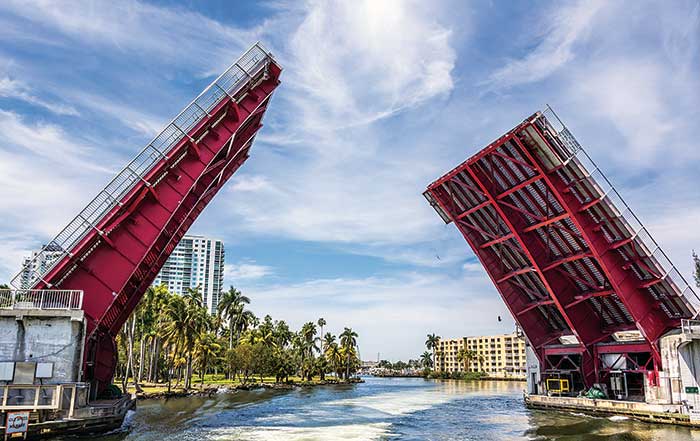Advertisement
Getting through a drawbridge safely requires good communication, knowledge of the bridge features, and a little courtesy.

Photo: Thinkstock
If you've never navigated a draw- or swing bridge, at first you may feel a little intimidated by the process. But don't worry. There are certain procedures you'll need to follow to make the process go smoothly. Here's how to get started.
Tip
You'll Need A Few Basics:
Consult guidebooks, if you have them onboard, for the name of the bridge and to see whether the bridge operates "on request" or by schedule. Check the USCG Local Notices to Mariners for temporary changes. Also check the chart for the bridge's vertical clearance. This number will be for "mean high water." The tide can be higher than this due to moon phase, winds, and other factors. Also construction projects may reduce vertical clearance. A Tide Table for the area will be helpful. Know the vertical clearance required by your boat, including masthead attachments. Tide boards at or near the fenders often state the bridge's vertical clearance at the present tide stage. The bridge does not have to open if you can get through by lowering your removable items such as antennas and outriggers. Requesting an unnecessary opening can result in penalties.
Plan Ahead:
Before you approach, take note of special navigation issues near the bridge such as strong current (particularly if it will be pushing you under the bridge), construction, unusual traffic (such as a boat ramp on the other side), or large vessel traffic with right of way. As you approach, SLOW DOWN, even if you can pass under the bridge without it opening. Check for speed-limit signs; kids swimming; people kayaking, fishing, or paddleboarding; small boats in trouble; and things that may be hanging down from the bridge where you must pass under.
Signal Your Intent:
In advance of your arrival at the bridge (often you should call well before), alert the bridge operator that you need an opening. Try to make contact on the VHF channel designated for bridge use in your area (usually 13 or 9). You may need to tell the bridge operator your location or type of boat so he can pick you out. Give enough notice so that he or she has time to let the traffic clear, and to operate the bridge.
Tip
Even if the bridge has scheduled openings, you should still call and advise the operator that you're standing by for his next opening. If you're part of a group of boats coming through, it'll help to advise him, but every boat in the group should also call and make the request.
If the bridge operator doesn't answer your call, assume he hasn't heard you. Continue trying to make contact; it's their duty to respond, for the safety of all. Most bridges have phones and some numbers are listed in guidebooks. If necessary, call. If all else fails, you can use a horn to sound one prolonged blast followed within three seconds with one short blast. The bridge tender should acknowledge with the same signal. If he responds with five short blasts, there's a problem. You should respond with five short blasts to indicate your understanding that you cannot proceed.
Listen To The Tender:
If you're able to make contact by VHF or phone, the bridge tender may have special instructions or warnings for you. If you have questions, ask. They probably can't give navigational advice, but can help by telling you about boats on the other side you can't see. Keep a VHF tuned to the bridge channel until you're clear.
Beware Of Traffic:
Beware of the operating restrictions of other boats. A boat on the other side of the bridge that's coming through with a current pushing it toward the bridge should normally be given right of way to come through first, because it may have maneuverability issues. So should a tug and barge, regardless of current. For many scheduled openings, there's boat-traffic congestion as boats wait. Try to stand back out of the way and communicate with other boats on VHF as needed. If you're aboard a sailboat, douse your sail and use your engine at the bridge.
Wait For It:
The bridge tender should signal, usually with one long and one short blast, that he's opening. Don't proceed until you see that his opening is completed. Some bridges have red and green lights that show when you can go through. Look on the other side for other boats coming through that may be in your way. Advise the bridge tender when you're clear. Be aware that some boaters may not know what to do and therefore cause problems. Five short horn blasts, from a boat or the bridge, should be used to signal emergencies or dangerous situations.
